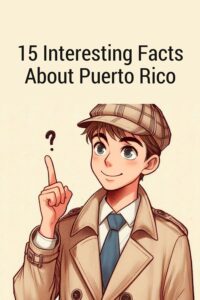Introduction
Puerto Rico, a tropical paradise in the Caribbean, is known for its rich cultural heritage that is a vibrant blend of Spanish, African, and indigenous Taino influences. From its colorful festivals to its mouthwatering cuisine, Puerto Rico’s culture is a melting pot of traditions that have been passed down through generations. In this article, we will explore 15 fascinating facts about Puerto Rico’s culture that will surely captivate your interest.
Fact 1: The Coqui Frog
One of the most iconic symbols of Puerto Rico is the Coqui frog, a small tree frog that is native to the island. The Coqui’s distinctive call, which sounds like “co-kee,” can be heard throughout the night in Puerto Rico’s rainforests, earning it the nickname of the “Singing Frog.”
Fact 2: The Flag of Puerto Rico
The flag of Puerto Rico, known as the “Bandera de Puerto Rico” in Spanish, features five equal horizontal bands of red and white, with a blue triangle on the left side that contains a white star. The colors of the flag are said to represent the bloodshed, liberty, and democratic government of the island.
Fact 3: The Vejigante Masks
During festivals in Puerto Rico, you may come across colorful masks known as Vejigantes. These masks, often adorned with horns, fangs, and bright colors, are worn by dancers who perform in celebration of Puerto Rico’s cultural heritage.
Fact 4: Bomba and Plena Music
Bomba and Plena are two traditional music styles that originated in Puerto Rico. Bomba is a lively drum-centric music that is often accompanied by dancing, while Plena features a call-and-response singing style that is performed with handheld drums called panderos.
Fact 5: The National Instrument: Cuatro
The Cuatro is a small guitar-like instrument that is considered the national instrument of Puerto Rico. It has five double strings and is often used in traditional Puerto Rican music, adding a distinctive and melodic sound to the island’s cultural expressions.
Fact 6: El Morro Fortress
El Morro Fortress, also known as Castillo San Felipe del Morro, is a historic fort in San Juan, Puerto Rico. Built in the 16th century to protect the island from attacks, El Morro is now a UNESCO World Heritage Site and a popular tourist destination.
Fact 7: The Three Kings Day Celebration
In Puerto Rico, the celebration of Three Kings Day, known as “Dia de los Reyes,” is a festive holiday that takes place on January 6th. Families often gather to exchange gifts, enjoy traditional foods like Rosca de Reyes (Kings’ Bread), and participate in parades and religious ceremonies.
Fact 8: The National Dish: Mofongo
Mofongo is a traditional Puerto Rican dish made with fried plantains, garlic, and pork cracklings, all mashed together into a flavorful and hearty meal. It is a staple of Puerto Rican cuisine and a favorite among locals and visitors alike.
Fact 9: The Ponce Carnival
The Ponce Carnival, held in the city of Ponce, is one of Puerto Rico’s most colorful and vibrant celebrations. The carnival features parades, music, dancing, and elaborate costumes, with participants and spectators joining in the festive atmosphere.
Fact 10: The National Drink: Pina Colada
The Pina Colada, a popular tropical cocktail made with rum, coconut cream, and pineapple juice, is said to have originated in Puerto Rico. The refreshing drink is often enjoyed by locals and tourists alike, especially on hot days by the beach.
Fact 11: The Vejigante Festival
The Vejigante Festival, celebrated in the town of Loiza, is a colorful and lively event that honors the African and Taino heritage of Puerto Rico. The festival features music, dance, and elaborate masks and costumes worn by participants.
Fact 12: The Taino Influence
The Taino people were the indigenous inhabitants of Puerto Rico before the arrival of the Spanish colonizers. Despite their near-extinction, the Taino culture continues to influence Puerto Rican traditions, art, and language, preserving a connection to the island’s ancient roots.
Fact 13: The El Yunque Rainforest
El Yunque National Forest, located in northeastern Puerto Rico, is the only tropical rainforest in the United States National Forest System. With its lush flora and fauna, cascading waterfalls, and scenic hiking trails, El Yunque is a natural wonder that showcases the beauty of Puerto Rico’s landscape.
Fact 14: The Grito de Lares
The Grito de Lares, or the Cry of Lares, was a rebellion that took place in 1868 in the town of Lares, Puerto Rico. Led by pro-independence revolutionaries, the uprising sought to overthrow Spanish colonial rule and establish an independent republic for the island.
Fact 15: The Salsa Music Scene
Puerto Rico has a vibrant salsa music scene that has produced world-renowned artists such as El Gran Combo, Tito Puente, and Marc Anthony. Salsa music, with its energetic rhythms and catchy melodies, is a beloved genre in Puerto Rico and has made a significant impact on the global music scene.
Conclusion
In conclusion, Puerto Rico’s culture is a captivating mosaic of traditions, music, cuisine, and history that reflects the island’s diverse heritage. From the lively rhythms of Bomba and Plena music to the colorful masks of the Vejigante dancers, Puerto Rico’s culture is a celebration of resilience, creativity, and community. Whether you’re exploring the historic sites of Old San Juan or savoring a delicious plate of Mofongo, the enchanting culture of Puerto Rico will leave a lasting impression on your heart and soul.
Subscribe to our email newsletter to get the latest posts delivered right to your email.



Comments